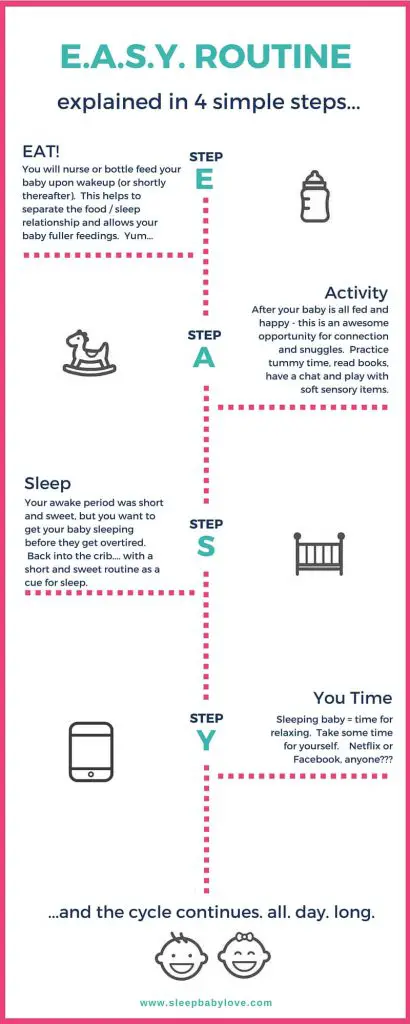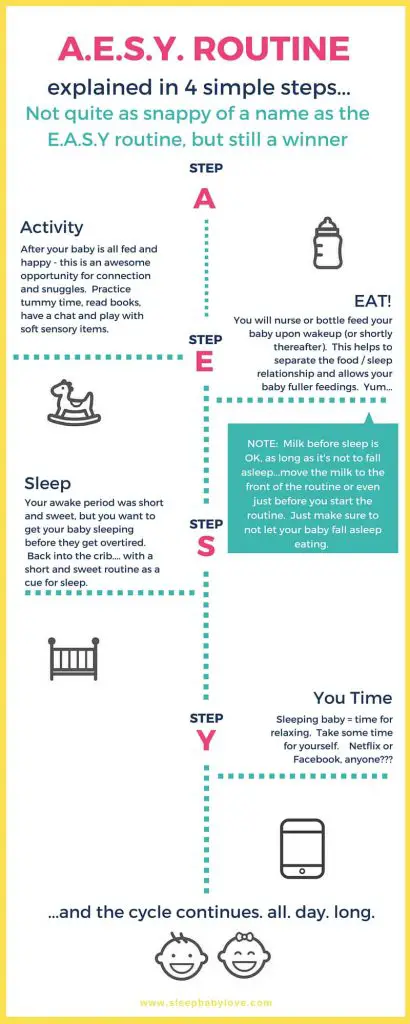If you have a short napper, you sure know that short naps suck! In fact, short naps plague so many families that they are the most common sleep struggle that I hear about. So many parents are frustrated and don’t know what to do to go from short naps to good naps.
But, turn that frown upside down – short naps don’t need to last forever! Just focus on these tips.
Tip #1: What is a short nap?
I define any nap less than an hour as a short nap. Short naps are not all created equal. Each nap gives me a clue to what’s going on.
1) A nap less than 30 minutes: Your baby is overtired and most likely will wake cranky.
2) A nap that is about 40-45 minutes: This is the length of your baby’s sleep cycle. It shows me that your baby can’t transfer sleep cycles and may not possess the appropriate soothing skills.
Of course, there are exceptions to this rule.
A 50-60-minute nap may not necessarily be considered short – it’s a gray area depending on your child’s behavior and ability to wake-up happy.
Plus, the last nap of the day (typically the 3rd nap after 4 months) is just a bridge nap – to get your baby enough fuel until bedtime. A nap for 30-minutes is O.K., and should be expected.
Tip #2: Are Short Naps Developmentally Appropriate?
As frustrating as short naps are, they can be developmentally appropriate for babies less than 4 months old. At this age, there is no consistency in sleep rhythms. You may see a 30-minute nap followed by a 2-hour nap. Or you may see several short naps in a row. Just set the stage at this stage for great sleep and keep your baby well-rested. Try not to stress if you can.
Right after the 4-Month Sleep Regression, we see sleep consolidate. But, still, it may be developmentally appropriate to see short naps up to 6 months.
Tip #3: Are Naps At The Right Time?
Since short naps can occur when your baby is overtired, focus on putting your baby down at an age-appropriate time. Here are some wakeful times to guide you to figure out the best nap time.
- Under 2 months: 45 minutes to 1 hour max
- 3 months: 1.5 hours max
- 4 months: 1.75 to 2 hours max
- 5 months: 2 hours max
- 6 months: 2.5 hours max
- 7 months: 2.75 hours max
- 8/9 months: 3 hours max
- 10/11 months: 3-4 hours max
- 12-14 months: 3-4 hours max on 2 naps, 4.5-6 hours max on 1 nap
You may be confused and want more information on the timing of naps. Baby Naps Made Easy, perfect for your baby. (and while you are at it take $50 off – to make it only $39)
Tip #4: Are Naps In A Dark Room?
When trying to lengthen short naps, take a look at where your baby is sleeping. These three components make for a perfect sleep environment:
- cool (68-72 degrees)
- dark
- quiet (with white noise)
Let’s focus on the DARK in that statement. Work on making your baby’s room CAVE dark. With the majority of blackout shades out there, light can still filter into the room (affecting your baby’s ability to transfer sleep cycles).
Now is the time to double up on window coverings: you can add blackout drapes on the outside of your blackout shades, buy a blackout liner (like this one) that covers the entire window. Of course, you can always use a DIY option. This will help to get the room dark, dark, dark!
Try a super dark room! What’s the worst thing that can happen? Your baby starts napping longer!
A craptastic short nap isn’t fun for anyone.
Tip #5: Does Your Baby Take An Age Appropriate Amount of Naps?
Assuming that your child knows how to fall asleep on their own and sleeps in the right sleep environment, sometimes there are better times to take naps than others.
Focus on the right amount of naps and the right amount of sleep for your baby’s age (after 4-6 months).
For example, If you have a 7 or 8-month-old, rather than having your baby take 3 crappy short naps a day, try and aim for a 2 nap schedule and aim for those naps to lengthen. Always recover from a bad nap day with an early bedtime!
I hear moms that are still keeping their baby up no longer than 2 hours which was made famous by Dr. Weissbluth’s book. Yes, that window of time is a great rule of thumb for a young baby, but past 6/7 months many babies outgrow that 2-hour waketime and can potentially get stretched in the morning to get a long nap.
E.A.S.Y Routine:
Short naps often occur when your baby is not falling asleep independently. Many babies are still nursed or bottle fed for sleep so the food is considered a sleep association (where they are unable to sleep without that cue). Try an E.A.S.Y routine where you actually move the feeding to right after a nap vs. before.
Food before a nap breaks the sleep-to-food relationship and actually can encourage fuller feedings vs. snacky ones.

A.E.S.Y Routine:
Similar to the E.A.S.Y routine, this routine, just gives you a guide to help break the food-to-sleep association that gets in the way of awesome sleep. So in this case, you are still feeding before bed, but just not feeding to sleep. See…it’s different.
So go ahead and try it (or pin the picture to refer back to it later).
Who’s Ready to Lengthen Naps?
The post Short Naps Suck! (5 Tips To Go From Short Naps to Good Naps) appeared first on Sleep Baby Love.




